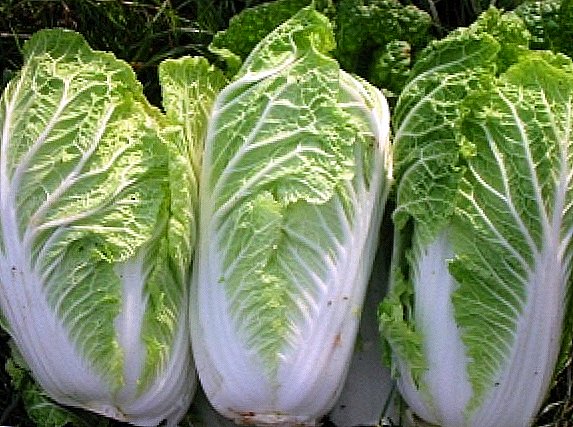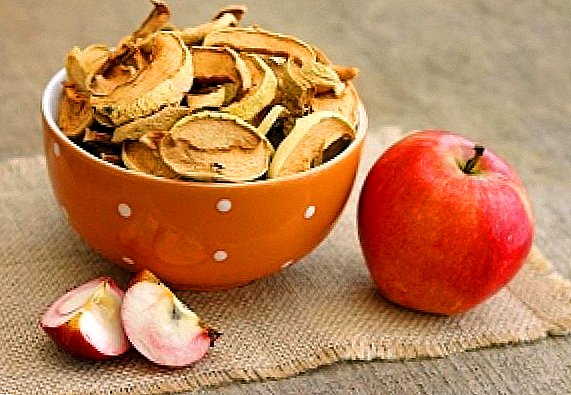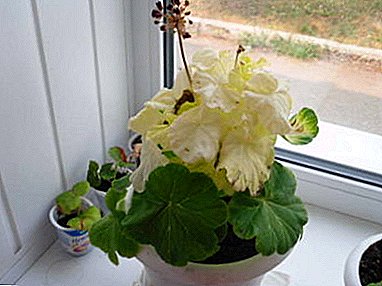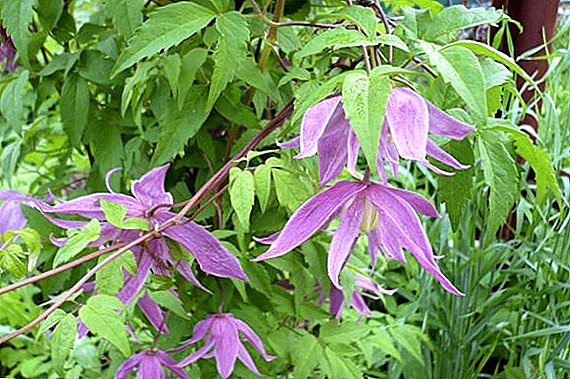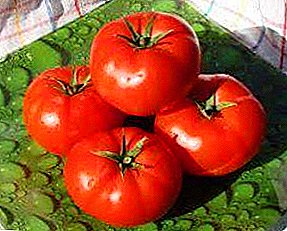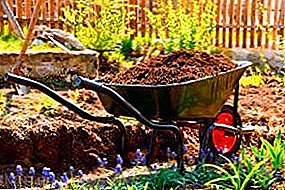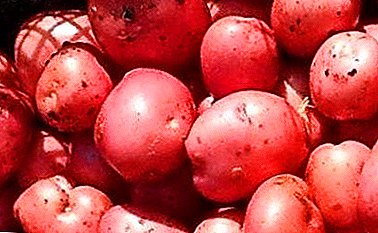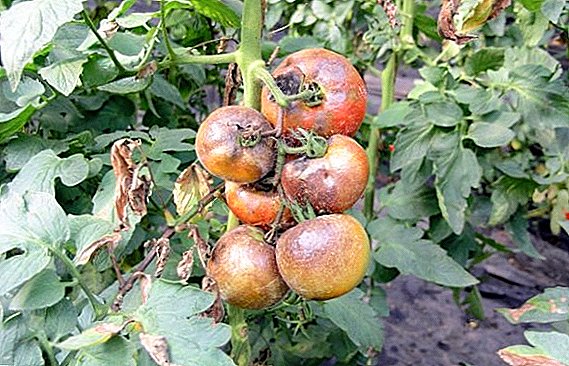 Every summer, all gardeners begin to grow their favorite fruits and vegetables in their plots, and in addition to their daily and customary cares, they have additional trouble to protect their crops from various types of diseases. Moreover, even the hottest summer quite often gives way to temperature changes and, as a result, it is noted by abundant torrential rains, which have an extremely negative impact on the health of some plants.
Every summer, all gardeners begin to grow their favorite fruits and vegetables in their plots, and in addition to their daily and customary cares, they have additional trouble to protect their crops from various types of diseases. Moreover, even the hottest summer quite often gives way to temperature changes and, as a result, it is noted by abundant torrential rains, which have an extremely negative impact on the health of some plants.
One of the most annoying and common in the suburban areas of the disease, which attacks mainly tomatoes, is phytophthora (fitoftoroz). And today we will explain in detail how to process tomatoes from phytophtoras in open ground or in a greenhouse and what folk remedies are better to use.
What is this disease?
Phytophthora is a serious disease of garden plants, the causative agent of which is the fungus Phytophthora infestans. Tomatoes most often suffer from this fungus, but there have been cases of infection and crops such as strawberries and even cucumbers. It is easy to trace the alarming symptoms on your vegetables: it is enough to reveal on the tomato tops gradually expanding spots of an ugly dirty-brown shade, which increase significantly faster during wet weather.  Such “blots” begin to appear on tomato leaves as early as 3 days after infection, and then, depending on weather conditions, contribute to the complete death of the shoots. Further, on the stems it will be possible to notice a gradually occurring grayish bloom, and on the fruits - wet and indented black spots, which will also gradually spread throughout the rest of the plant surface.
Such “blots” begin to appear on tomato leaves as early as 3 days after infection, and then, depending on weather conditions, contribute to the complete death of the shoots. Further, on the stems it will be possible to notice a gradually occurring grayish bloom, and on the fruits - wet and indented black spots, which will also gradually spread throughout the rest of the plant surface.
Find out why leaves turn yellow and curl in tomatoes, how to deal with top rot and powdery mildew on tomatoes.
No one is insured against late blight of the garden plot, but some causes and conditions still contribute to the occurrence of this disease:
- cold weather and frequent rains;
- failure to comply with the required temperature regime (in greenhouses) for tomatoes;
- Covering tomatoes with a film of cold during temperature fluctuations (day and night) promotes the formation of condensate, which, in turn, provokes the development of phytophthora.

Did you know? In the world there is not a single continent free from the phytophthora genus - 70 its species can calmly and calmly destroy all known cultural plants.
Folk remedies
To date, the domestic market has a rich assortment of various chemical agents that can cope with annoying blight for the first time and for a long time delay the inevitable death of the plant, since it is no longer possible to completely defeat the disease that has appeared.
But as practice has shown, late blight can be avoided altogether - to do this, you just need to take effective preventive measures in time, which consist of the old, proven over the years folk methods. And to find out exactly what tools will help in the fight against blight on tomatoes in open areas or in the greenhouse, we turn to the following points.
And to find out exactly what tools will help in the fight against blight on tomatoes in open areas or in the greenhouse, we turn to the following points.
Garlic and Manganese
A well-known universal solution of potassium permanganate with garlic has long been the best preventive tool in the fight against fungal attack. The technology of its preparation is very simple, and effective disinfectant properties are striking in their effectiveness. To prepare the solution, you need to act in stages:
- In a meat grinder, 100 grams of garlic are minced, with all of its parts at once: leaves, onions and arrows.
- The garlic mixture is poured with a glass of clean water and left for 24 hours at room temperature, in a dry and cool place.
- Before using the present concentrate diluted with water (10 liters).
- It is necessary to spray tomatoes every 2 weeks in calm and dry weather.
Important! If there are risks of rotting of fruits from phytophtoras before full ripening, then it is better to pick them, hold them in water (temperature - 35WITH) with potassium permanganate for about half an hour, then dry and allow them to ripen in a dry open place, for example, on a windowsill.
Straw infusion
If you have chosen straw infusion as a preventive weapon against late blight, it is important to remember that the main ingredient must be rotten (hay or straw). The straw is poured with ten liters of water, a handful of urea is added to the mixture, and then it is infused for three days.  Then the finished tincture is thoroughly filtered and further sprayed with tomatoes every two weeks.
Then the finished tincture is thoroughly filtered and further sprayed with tomatoes every two weeks.
Not only tomatoes, potatoes, cabbage and other garden crops, but also houseplants suffer from phytophtorosis, as well as spatifilum, kalanchoe, violets, gloxinia, and azalea.
Milk serum
Whey has long been known to experienced summer residents for its undeniable efficacy in the war against the phytophthora fungus: it forms a thin, almost imperceptible film on tomato leaves that prevents harmful microorganisms from seeping into vegetable tissues and putting their roots there.
Fungal infections of various types are always trying to “bypass” the plants treated with serum, since the milk bacteria and microflora contained in it are detrimental to them. But the irrigation procedure should be repeated, not forgetting, since the serum itself is short-lived and very quickly loses its antimicrobial effect. Some sources say that it is the spray pattern once every 10 days that is the most effective, but based on the experience of many agronomists and gardeners, we concluded that the manipulation should be carried out as often as possible, even every day. But, in order to apply the serum for its intended purpose, it must first be converted into a working solution - for this it is diluted with water in a 1: 1 ratio. In this way, it is possible to safely process tomatoes from ill-fated phytophtoras both in the greenhouse and in the open area.
Milk and iodine
No wonder many people professional growers tomatoesconsidered the best prevention from phytophthora processing plants with a solution of milk and iodine, because its disinfectant properties not only kill disease-causing bacteria, but also contribute to the rapid and high-quality process of ripening tomato fruit.  For the preparation of such a solution will require only half a cup of skim milk, clean water and a couple of drops of iodine (no more adding, it can burn the leaves). Milk and iodine are added to 1 liter of water, then the exposed mixture should be carefully sprayed on all unprotected areas.
For the preparation of such a solution will require only half a cup of skim milk, clean water and a couple of drops of iodine (no more adding, it can burn the leaves). Milk and iodine are added to 1 liter of water, then the exposed mixture should be carefully sprayed on all unprotected areas.
Important! For higher efficiency, the processing of tomatoes from phytophthora with iodine should be alternated with processing with garlic tincture.
Saline solution
If you find symptoms of late blight on ripening tomatoes, then the best option would be to give the tomato fruit that is not yet sick to ripen and be harvested faster.
For this purpose, without using any chemicals, normal salt solution is well suited: it allows the stems to get rid of the affected leaves as soon as possible, thereby giving the bush extra time and energy to accelerate the ripening of the fruit, and also completely covers the entire plant with a salt film, which significantly slows the development of the fungal disease. For its preparation is used only 100 g of salt per 1 liter of water.  It is also important to remember that only diseased areas with plants can be irrigated with saline, because it can cause harm to other garden crops.
It is also important to remember that only diseased areas with plants can be irrigated with saline, because it can cause harm to other garden crops.
Kefir
For quite a long time obsessive fungi will help keep the usual kefir. For thorough processing, you first need to prepare a working solution, which consists of 1 l of kefir and 5 liters of water. Tomatoes with this tool should be started to spray only 14 days after planting seedlings on a permanent territory, and then the manipulation is carried out already every week.
Ash solution
For destruction of lateral spores, which are just beginning to sprout on tomato soil, a solution with ash content is very often used, which has strong disinfecting properties and destroys, in addition to fungi, other infections affecting plants. This tincture is prepared quickly and easily: 250 ml of ash is poured with a liter of water, boiled on the fire for 15 minutes. The resulting mixture is carefully filtered, and then another 10 liters of water is added to it.
Now you should take care of the spraying solution for the bushes to fix the result of disinfection: 6 liters of ash is thoroughly mixed with ten liters of water, and then the mixture stands in a dark place for at least three days.  Spraying tomato seedlings should be carried out 3 times, the first - when the seedlings take root in the soil, the second - before the start of flowering, and the third - when the first ovaries appear.
Spraying tomato seedlings should be carried out 3 times, the first - when the seedlings take root in the soil, the second - before the start of flowering, and the third - when the first ovaries appear.
Pipe Spraying
Slicing sprays will be very useful for tomato bushes that have not yet suffered from phytophthora. It is paradoxical, but it just so happens that the mushroom is able to act as a serious obstacle to the development of other harmful fungi, especially for the late blight.
The following tomato varieties have a high resistance to phytophthora: "Katya", "Bearded," "Raspberry Giant", "Dubrava", "Little Red Riding Hood", "Batyana", "Budenovka", "Gina", "Honey Drop".
Planting should be irrigated at the time of fruit set, every 10 days early in the morning, preferably in calm and windless weather. The recipe for preparing the grout solution is as follows: the dried mushroom (100 g) is crushed in a meat grinder and filled with boiling water, after complete cooling, the mixture is filtered, and the solution immediately becomes suitable for use. 
Copper
German scientists have come up with an interesting method of controlling late blight: it consists in wrapping the root system of seedlings with thin copper wire. Our agronomists have adapted this method in their own way - they invented to pierce such a stem of a bush with such wire. The method looks strange, but it is amazingly effective: due to the copper microdose of the plant, chlorophyll is stabilized, and the correct oxidative processes are restored.  But it is important to remember that such manipulation can be carried out only on strong tomato stems.
But it is important to remember that such manipulation can be carried out only on strong tomato stems.
The process of copper introduction is carried out in stages:
- A thin copper wire is trimmed with sandpaper or ignited, then cut into small pieces of 3 cm.
- Puncture of the stem is done not necessarily near the soil, but at a distance of about 10 cm
- The wire is gently inserted into the stem, its ends are bent down.
- Wrap the stem is strictly impossible.
Did you know? The first person who discovered that the phytophthora is afraid of copper was one unknown, meticulous journalist (unfortunately, his name has not even been preserved in history). But precisely because of his observation, people saw that the nasty fungus does not manifest itself near copper smelters, and then the Germans patented Now known to us saving method with wire.
Yeast
At the initial stage, the most common baker's yeast is perfect for controlling late blight. For effective spraying, just 100 grams of the product is sufficient, which should be dissolved in 10 liters of water. Then the solution must be applied for its intended purpose. 
Prevention
Of considerable importance in the fight against late blight on tomatoes, in the greenhouse and on the open ground is another pre-prevention, which is carried out by similar folk remedies. If you try to carry out all these methods, you will be able to forget about late blight at least for a while. For a good result, you must perform the following actions:
- Prevention is desirable to begin in the early stages of planting: for this you need to process the vegetable seeds. Usually seeds are soaked in a solution of potassium permanganate for 20 or 30 minutes.
- Pick up early varieties less sensitive to fungus.
- In the process of planting seedlings, prepared for tomatoes, pits should be plentifully treated with copper sulfate (1 tbsp per 10 liters of water).
- Ensure a good distance between landings (at least 30 cm).
- When the fruits of the first brush appear on the bushes, it is necessary to remove the lower leaves.
- To monitor the appearance on the tops of bushes of flowers and brushes - it is desirable to tear them off in time.


